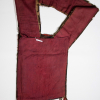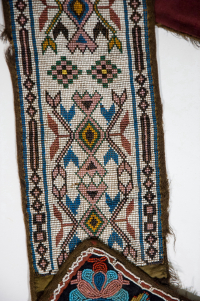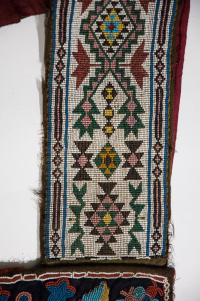Bandolier bag
Bandolier bag
Bandolier bag











Bandolier, stroud, loom woven beadwork pouch panel, straps, symmetrical and asymmetrical decorative beaded designs.
Based on catalogue description
Read More About This Relative
Cotton and wool fabrics, cotton thread, woven seed beadwork, green and red bias tape.
Hand sewn, Straps and bag backed with faded burgundy cotton material, Materials for strap from outside bottom to top are two layers of striped worn cotton material and heavy blue woollen material, Woven beadwork panel attached to heavy material with cotton thread around length of bunched woollen strands which act as piping around panel, Outside edges of strap covered with dark green bias tape inset 0.5 cm from edge to bead panel, Bias tape stitched across ends of straps for 5 cm, Face of pouch decorated with large panel of woven beadwork, Panel framed on top and sides with bias tape, green at sides and four alternating rows of green and red, along top, Tape decorated with applied beadwork of white seed beads in double linked diamond chain at sides and six otter track rows at top, Along red tape, which frames entire pouch section, more applied linked diamond chain beadwork, Dark blue woollen fabric panel above pouch embroidered with applied beadwork using coloured seed beads in floral pattern attached using single strand cotton thread with overlaid spot stitches, Construction of bag and straps similar, Several layers of fabric used as backing, Rim of patterned cotton material stitched around perimeter of bag along top 14 cm and along sides 4 cm, Layer of dark blue woollen stroud-like material covers back of bag and extends up to cover upper section, Bag lined with striped cotton-like material, Outer edges of bag top and sides trimmed with two rows of bias tape, medium green and medium red, Two strips of tape extend down beyond bottom's edge, 15 cm as bottom tabs.
Strap illustrates asymmetrical decorative elements while pouch panel illustrates symmetrical geometric configurations, Floral-curvilinear type motif, including squares, rectangles, triangles, diamonds, Embellishments added are arrows, wings and arms, Elements have stepped or serrated square or triangular sides, Borders of straps and centre panel include otter track design, Design on woolen panel comprised of two symmetrically arranged floral units, from which vine-like stems emerge, Floral elements composed of petals, stems, vines and leaves in colours of pink, blue, green, yellow, red.
Worn for festive occasions, may possibly have served at ceremonial functions as well.
"Bandolier bags most likely originated in the Upper Great Lakes region during the 1840s and 1850s. Fashioned exclusively from European materials and adorned with thousands of beads, bandolier bags were primarily for show, as a symbol of identity, wealth and status. Although initially functional, by the late 19th and early 20th centuries many of the bags had false pouchs or none at all. Sometimes called "friendship bags", they were often created as gifts to strengthen relationships within communities or between nations. By the 1870s they had become an important element of formal dress worn mainly at ceremonies and celebrations by men, and occasionally by women. They wore them - singly or several at a time - crossed over the torso or draped around the neck. The wearing of more than one bag was generally the prerogative of a leader or a person of high honour." (McCord, 2013) Bandolier adopted by Ojibwa in 19th century after seeing bullet pouches used by British soldiers. Bullet pouches were plain and decorated with crest or coat of arms. When idea adopted by Ojibwa, they were greatly prized and highly decorated ceremonial accessories. They became so highly prized by Ojibwa and other tribes (especially Sioux), that one bandolier could be traded for one pony. They became a status symbol of highest ranking Midewiwin priests. Source of Function Data Includes: McCord Museum, Wearing Our Identity. Montreal: The McCord Museum, 2013; Print.
Provenance
About This GRASAC Record
Manitoba Museum
45.6426, -85.036
Attributed to Plains area
 Knowledge Sharing Platform
Knowledge Sharing Platform










